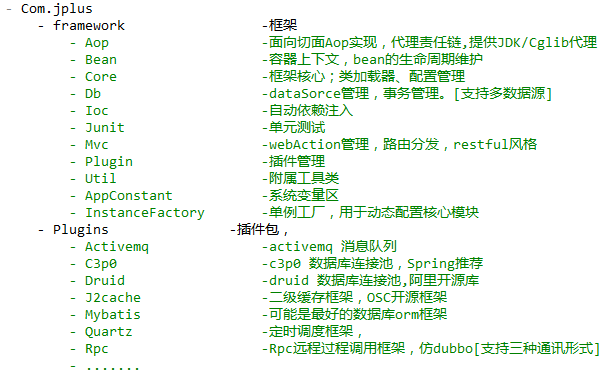Jplus-core说明
声明
jplus 是一个java框架,web只是他的一个模块,他并非重复造轮子,初衷是希望把所有好的合适的框架集合到一起,能发挥出对开发者更大的作用。
框架思想主要学习黄勇 的smart,推荐大家去看看;
关于Jplus
- 支持零配置,所有配置可由.properties或代码管理。
- 提供可以媲美Spring的 IOC、AOP、MVC,及各种强大的第三方定制插件。
- 快速开发,框架~200Kb,所有插件可插拔。
jplus 简介
项目启动顺序:
初始化 -->CoreLoader -->BeanHandle -->ActionHandle -->PluginHandle -->AopHandle -->IocHandle -->完成关于Bean管理
项目启动后CoreLoader 加载 BeanHandle,同时BeanHandle 初始化ConfigHandle, 获取一系列相应的用户配置信息properties。
然后扫描 ${app.scan.pkg} 包中所有带@Component注解的class,完成bean的发现。
PS:在项目中运行时获取 bean 对象可以使用:BeanHandle.getBean(Classcls);
1. 快速创建一个jplusMvc项目
首先我们创建一个simple Maven Project
然后第一步创建一个HelloAction.java用于接收用户请求:package com.demo.mvc.action; import com.jplus.core.mvc.WebUtil; import com.jplus.core.mvc.annotation.Controller; import com.jplus.core.mvc.annotation.Request;
@Controller public class HelloAction {
@Request.All("{msg}") public void index(String msg) { System.err.println("== This is Restful Action ==========="); WebUtil.writeHTML(msg); }}
然后我们看见,包名是com.demo开始的,现在配置注解扫描配置,在project的classpath目录下,添加文件:app.properties
app.scan.pkg=com.demo
[附加]其实到第二步,项目就可以启动了,但为了debug方便,添加日志配置,在classpath目录下,添加:log4j.xml
<log4j:configuration xmlns:log4j="http://jakarta.apache.org/log4j/" debug="false">
最后添加Tomcat容器,启动访问:localhost:8080/hello试试吧~
2. 关于JplusMvc的相关配置
关于MVC注解
注解:**@Controller**
使用说明:用于定义Action配置。类上加上此注解,该类将被定义为Action处理的接收类。
使用方式:直接在请求处理类上加上此注解即可。注解:**@Request**
使用说明:用于定义请求的UrlMapping,对用户的请求根据路径做路由分发。
使用方式:见下方代码,默认提供六种配置方式,对应于不同的http请求:
@Request("xxx") => 用于公共请求前缀,作用于类上
@Request.All("xxx")=> 用于接受所有匹配的请求,作用于方法上
@Request.Get("xxx")=> 用于接受Http get请求,作用于方法上
@Request.Post("xxx")=> 用于接受Http post请求,作用于方法上
@Request.Put("xxx")=> 用于接受Http put请求,作用于方法上
@Request.Delete("xxx")=> 用于接受Http delete请求,作用于方法上package com.demo.mvc.action; import com.jplus.core.mvc.WebUtil; import com.jplus.core.mvc.annotation.Controller; import com.jplus.core.mvc.annotation.Request; @Controller @Request("user/") public class UserAction {
@Request.All("info") private void info() { WebUtil.writeHTML("This is Page info"); }
@Request.Get("{id}") private void getUser(int id) { WebUtil.writeHTML("This is a get user info by id,id:"+id); }
@Request.Post("add") private void addUser() { WebUtil.writeHTML("This is add Page"); }
@Request.Put("edit") private void editUser() { WebUtil.writeHTML("This is edit Page"); }
@Request.Delete("{id}") private void delUser(int id) { WebUtil.writeHTML("This is del Page,user id is :" + id); } }
注解:**@Param**
使用说明:用于设置请求入参,通过入参名称,获取restful/get/post形式的参数。
使用方式:见下方代码:/** * 发现和上面getUser的方法的区别了么, * 上面直接取值,使用的下标取值,取的restful请求中的占位符{xx}中的值,然后按下标依次取,支持类型:int/long/Double/BigDecimal/String * 下面通过@Param取值,使用名称key取值,可以取restful/get/post...等各种方式提交的值,支持类型:int/long/Double/BigDecimal/String */ @Request.Get("{id}") private void getUser2(@Param("id") int userId) { WebUtil.writeHTML("This is a get user info by id,id:"+userId); }
注解:**@Form**
使用说明:用于标示POJO实体对象的请求入参,作用于实体类上。
使用方式:当一个pojo实体对象为入参时(form表单提交),框架会自动将入参填充到对象中去。见下方代码:==>UserForm.java @Form public class User { private int id; private String name; private String age; /** ... omit get/set/toString method ... */
}
==> UserAction.java @Request.Post("add") private void addUser(User user) { System.err.println("I can get form param:"+ user.toString()); WebUtil.writeHTML("This is add Page"); }
注解:**@Service**
使用说明:用于标记实现类,供框架扫描,作为IOC注入到其他类中,作用于类上,一般用于Service层。又一个默认参数[名称],非必填。
使用方式:@Service用于标记扫描,等待其他类使用@Autowired 注入,
@Service可以添加参数名 @Service("xxx"),然后注入的地方使用@Autowired("xxx")进行注入,见下方代码:==> UserService.java @Service public class UserService {
public Result add(User form) { Result res = new Result().OK(); System.err.println("Add Service :" + form.toString()); return res; } }
==> UserAction.java
@Controller @Request("user/") public class UserAction { private @Autowired UserService userService;
@Request.Post("add") private Result addUser(User form) { return userService.add(form); } }
关于MVC上下文
DataContext.java
DataContext为整个MVC的上下文容器,生产周期为当前请求。
里面封装了Cookie,HttpServletRequest,HttpServletResponse,ServletContext,Session等相关对象的处理。WebUtil.java
Web 操作工具类,依赖于DataContext,提供了取参,输出,转发请求等实用功能。视图输出:View.java
视图输出,将请求执行完毕,返回到JSP页面进行渲染,然后返回也客户端页面。
默认视图地址[在properties中配置]:app.view.path=/WEB-INF/jsp/@Controller @Request("hello/") public class HelloAction { @Request.All("page") public View page() { System.err.println("== This is page Action ==========="); //跳转到 : /WEB-INF/jsp/hello/page.jsp return new View(); } }
JSON输出:Result.java
JSON输出,将请求执行完毕,返回到前端JSON字符串。
推荐使用Result作为方法返回值。用户也可以自定义任何对象输出,默认都为JSON格式。@Request.Get("JSON") public Result getJSON() { System.err.println("== This is page Action ==========="); // 返回JSON : {"code":1,"obj":"请求成功"} return new Result().OK().DATA("请求成功"); }
3. 关于JplusAop的相关配置
说明:使用jdk,Cglib动态代理技术实现,采用责任链模式,递归代理。
默认AOP提供三种代理:
AspectProxy.java 切面代理,提供6种切点方法:
//开始 public void begin() //拦截[根据boolean判断是否继续执行方法] public boolean intercept(Class cls, Method method, Object\[\] params) //方法执行前 public void before(Class cls, Method method, Object[] params) throws Throwable //方法执行后 public void after(Class cls, Method method, Object\[\] params, Object result) //抛出异常 public void error(Class cls, Method method, Object[] params, Throwable e) //结束 public void end()
使用方式:
对自定义切面类继承AspectProxy抽象类,并重写目标方法, 然后对该类添加@Aspect注解。注解:@Aspect _(该注解有三个属性值:)_:
pkg:想要被代理类所在的包名。
cls:想要被代理的具体类,和pkg二选一。
annotation:想要被代理的类是有指定注解的类注解:@AspectOrder :
该注解是@Aspect的补充,对链式AOP做排序,若有@AspectOrder注解,则优先比较(序号的值越小越靠前)代码示例:
package com.demo.mvc.aop; import java.lang.reflect.Method;
import org.slf4j.Logger; import org.slf4j.LoggerFactory; import com.jplus.core.aop.AspectProxy; import com.jplus.core.aop.annotation.Aspect; import com.jplus.core.mvc.DataContext; import com.jplus.core.mvc.annotation.Controller;
/** * AOP拦截器演示
* 测试拦截指定包名下所有的Action * @author Yuanqy */ @Aspect(pkg = "com.demo.mvc.action", annotation = Controller.class) public class ActionInterceptor extends AspectProxy { private Logger logger = LoggerFactory.getLogger(getClass());ThreadLocal
curTimes = new ThreadLocal (); @Override public void before(Class<?> cls, Method method, Object[] params) throws Throwable { curTimes.set(System.currentTimeMillis()); logger.info("===Is new RequestURI:" + DataContext.getRequest().getRequestURI()); logger.info("===Action:{}.{}", cls.getName(), method.getName()); }
@Override public void after(Class<?> cls, Method method, Object[] params, Object result) throws Throwable { logger.info("===Action is complete,time:{}ms \n", (System.currentTimeMillis() - curTimes.get())); curTimes.remove(); } }
TransactionProxy.java 事务代理:
使用方式:
在想要被事务代理的类、或类的方法上添加注解:**@Transaction**即可。**注解:@Transaction**:
类似于Spring的事务,支持事务传播,支持配置事务隔离级别(默认level=4)
作用于类上,表示当前类中所有方法开启事务。
作用于方法上,表示当前方法开启事务。代码示例:
@Service public class UserService {
@Transaction public Result add(User form) { Result res = new Result().OK(); // TODO something... return res; }}
PluginProxy.java 插件代理:
使用方式:
他是对于上诉两种代理的补充,可以用于扩展任意规则、任意场景代理实现。
该类仅有一个获取代理链方法:/** * 具体代理被执行时,会执行实现了Proxy接口的doProxy()方法. * 使用方式:请参考:com.jplus.j2cache.proxy.J2CachePluginProxy * 原理: * 项目启动时,先扫描缓存bean,当AopHandle运行时,执行插件代理的getTargetClassList方法。 * 该方法由开发人员自己定义筛选规则,将满足条件的对象bean集合返回,做AOP代理; * 在项目运行期,代理的对象执行时,通过链式代理,找到当前类,执行doProxy()方法,完成代理操作。 */ public abstract List<Class<?>getTargetClassList()
4. 关于JplusIOC的相关配置
框架中,ioc初始化位于项目启动最后阶段。 之前的MVC,AOP,Plugin 已经是创建了所有项目中所需的bean对象, 在最后要做的就是把这些 对象 互相关联起来,建立原本的依赖关系。
**注解:@Autowired**:
使用方式:
//通过接口注入,框架会找到容器中的第一个接口实现类进行注入,实现类必须>=1,否则异常 private @Autowired IIocDemo demo;// 通过接口注入
//通过指定接口实现注入,实现类上必须标明当前名称@Service("xxx")才能注入成功 private @Autowired("xxx") IIocDemo demo;// 通过指定接口实现注入
//这个没什么好说的,直接注入目标类即可 //PS.只要是bean容器管理了的对象,都可通过@Autowired注入。 private @Autowired IocDemoImpl demo;// 通过指定对象注入
**注解:@Value**:
使用方式:
//方式1:@Value("xxx") //方式2:@Value("${xxx}") 两种方式效果一致 private @Value("app.scan.pkg") String scanPkg;// 注入配置文件
**注解:@Component**:
@Component注解是其他注解的元注解。jplus的扫描规则是扫描所有继承或使用Component注解的类,然后加入bean管理。使用方式:
/** * 属于Bean扫描注解,任何需要加入IOC的组件类,都 可以添加该注解。 * 该注解提供两个参数[都非必填项]: * initMethod:填入当前类的方法名,项目启动后会执行该方法 * destroyMethod:填入当前类的方法名,项目注销前会执行该方法 */ @Component(initMethod = "init", destroyMethod = "destroy") public class InitComponent { public void init() { System.err.println("== 项目启动后会执行该方法 =="); }
public void destroy() { System.err.println("== 项目注销前会执行该方法 =="); } }
代码示例:
/** * 接口类 */ public interface IIocDemo { Result addUser(User user); Result getUser(int id); }
/** * 实现类 */ //@Service @Service("iocDemoImpl") public class IocDemoImpl implements IIocDemo {
private Map<Integer, User> map = new HashMap<>(); @Override public Result addUser(User user) { map.put(user.getId(), user); return new Result().OK().DATA("新增成功"); } @Override public Result getUser(int id) { if (map.containsKey(id)) return new Result().OK().DATA(map.get(id)); else return new Result().FAIL().DATA("数据不存在"); }}
/** * 在Action中注入 */ @Controller @Request("ioc/") public class IocAction {
private @Autowired IIocDemo ioc1; // 通过接口注入 private @Autowired("iocDemoImpl") IIocDemo ioc2; // 通过指定接口实现注入 private @Autowired IocDemoImpl ioc3; // 通过指定对象注入 private @Value("app.scan.pkg") String scanPkg; @Request.Get("test") private void iocTest() { System.out.println(ioc1.addUser(new User(1, "张三"))); System.out.println(ioc2.getUser(1)); System.out.println(ioc3.getUser(1)); WebUtil.writeTEXT("OK"); }}
5. 关于Jplus Junit的相关配置
jplus框架默认集成 Junit4 单元测试框架。
使用方式:
测试类添加两个注解:@RunWith [Junit框架注解]、@ContextConfiguration [Jplus框架注解] 即可。
RunWith注解大家可以百度下使用方式,现在说明下ContextConfiguration注解。注解:@ContextConfiguration
ContextConfiguration用于配置配置文件路径。通过参数locations配置,说明如下:"file:/app.properties" //系统根目录 "app.properties" //项目根目录 "/app.properties" //项目WEB-INF下 "classpath:app.properties" //项目ClassPath下 //如果有多个配置文件,可以用 ; 分号分割,如下: "file:/db.properties;classpath:app.properties" //多个配置文件.一个文件目录下;一个classpath目录代码示例:
/** * JplusJunit4 测试框架IOC功能 */ @RunWith(JplusJunit4Runner.class) @ContextConfiguration(locations = "classpath:app.properties") public class JunitIOC {
private @Autowired("iocDemoImpl") IIocDemo ioc3; private @Autowired IocDemoImpl ioc2;
private @Value("app.scan.pkg") String scanPkg;
@Test public void test() throws InterruptedException { System.out.println("添加用户:" + ioc3.addUser(new User(1001, "Jplus"))); System.out.println("获取用户:" + ioc2.getUser(1001)); System.out.println("app.scan.pkg=" + scanPkg); Thread.currentThread().join(); } }
6. 关于JplusMVC的后端参数验证
对于请求入参,JPlus可以通过拦截器做公共参数校验,对于form表单对象,可以使用工具类进行校验。
使用方式:
对于form表单对象(可以理解为添加了@Form注解的pojo类),当该对象作为请求入参时,正常情况参数的校验都是固定的字段,固定的规则。而且开发人员也不想在业务代码里面进行入参判断。这时候就可以使用:**Result res= VerifyUtil.doVerify(form);**通过返回Result判断校验结果。
原理:对入参对象的字段进行处理,判断是否有@V注解,对@V注解的字段进行判断处理。注解 @V:
注解名
默认表达式
默认返回描述
是否可为空
IsNotNull
\w+
字段{}不能为空
FALSE
IsCN
^[\u4e00-\u9fa5]+$
字段{}不是汉字
TRUE
IsDigits
^[0-9]*$
字段{}不是纯数字
TRUE
IsFloat
^[0-9]*$
字段{}不是小数
TRUE
IsEmail
^\w+([-+.]\w+)_@\w+([-.]\w+)_\.\w+([-.]\w+)*$
邮箱格式不正确
TRUE
IsIdCardNo
^(\d{6})()?(\d{4})(\d{2})(\d{2})(\d{3})(\w)$
身份证号不正确
TRUE
IsPhone
^[1][0-9]{10}$
手机号码不正确
TRUE
IsPwd
^(?![0-9]+$)(?![a-zA-Z]+$)[0-9A-Za-z]{6,16}$
密码格式不正确
TRUE
IsTel
^(0\d{2}-\d{8}(-\d{1,4})?)|(0\d{3}-\d{7,8}(-\d{1,4})?)$
电话号码不正确
TRUE
IsZipCode
^[0-9]{6}$
邮政编码不正确
TRUE
Custom
未定义
TRUE
PS:@V.Custom()用于给用户自定义校验规则及返回说明。还支持JPEL表达式。
代码示例:
/** * Form入参表单 */ @Form public class User { @V.IsNotNull @V.IsDigits private int id; //表示id必须为数字,不能为空 private String name; @V.Custom(regex = "el:{}>=18 && {}<30", retmsg = "年龄必须在18~30岁之间",isNull=false) private String age; //表示 自定义用JPEL表达式判断年龄范围,不能为空 @V.Custom(regex="^[A-Za-z]+$",retmsg="请输入正确的URL") private String url; //表示 自定义用正则表达式判断 @V.IsPhone private String phone; //表示 必须为手机号,可为空 } //====================================================== @Controller @Request("user/") public class UserAction { private @Autowired UserService userService; @Request.Post("add") private Result addUser(User form) { //执行入参验证 Result res = VerifyUtil.doVerify(form); if (res.IsOK()) return userService.add(form); return res; } }
7. 附加:关于Jplus的JPEL表达式的使用
使用逆波兰算法实现,相比js引擎,效率提升>15倍,后续会逐渐优化,支持特性:
- 算数运算表达式:
加(+)、减(-)、乘(*)、除(/)、求余(%)、幂(^)运算 - 关系表达式:
等于(==)、不等于(!=)、大于(>)、大于等于(>=)、小于(<)、小于等于(<=) - 逻辑表达式:
且(&&)、或( || )、非( ! )、true、false - 括号优先级表达式:
使用“(表达式)”构造,括号里的具有高优先级。 - 不支持三目运算,不支持文本字符串
- 算数运算表达式:
使用方式:
//参见代码:com.jplus.core.util.JPEL.java
String calc = "1+2*(3+4)-5+(-2)*8/2+8 == 5*6/2-5 && 10%4*3>-1+2*3"; System.err.println("中缀表达式:" + calc); // == 逆波兰 ======================== long t = System.currentTimeMillis(); System.out.println("逆波兰=" + excute(calc) + "\ttime:" + (System.currentTimeMillis() - t)); // == JS引擎========================== t = System.currentTimeMillis(); System.out.println("JS引擎=" + getSE().eval(calc) + "\ttime:" + (System.currentTimeMillis() - t));
8. 附加:关于Jplus多数据源的配置
多数据源可以支持申明式配置和编程式配置两种,具体方法参考jplus-orm说明文档。
编程式配置 实例:
/** * JplusJunit4 测试Jplus-core编程式多数据源切换 */ @RunWith(JplusJunit4Runner.class) @ContextConfiguration(locations = "classpath:app.properties") public class JplusDDS {
@Test public void test() { JdbcTemplate jt = null; try { // 1.创建N个数据源,可选用C3p0,Druid...都可以 DataSource ds1 = new C3p0Plugin("jdbc:mysql://139.196.18.60:3306", "root", "password", "com.mysql.jdbc.Driver").getDataSource(); DataSource ds2 = new C3p0Plugin("jdbc:mysql://192.168.1.16:3306", "root", "password", "com.mysql.jdbc.Driver").getDataSource(); // 2.将N个数据源放入DynamicDataSource中,并定义key名称 Map<String, DataSource> map = new HashMap<String, DataSource>(); map.put("readone", ds1); map.put("readtwo", ds2); DynamicDataSource dds = new DynamicDataSource(map); // 3.创建一个JdbcTemplate,使用数据源为DynamicDataSource jt = new JdbcTemplate(dds); // 4.循环测试数据源切换\[ps.我事先准备了两个不同版本的mysql\] for (int i = 0; i < 3; i++) { if (i == 2) jt.openTransaction(); // 最后一次开启事务 DataSourceHolder.setDbType("readone"); System.err.println("\[切换1\]:" + JSON.toJSONString(jt.query("SHOW VARIABLES LIKE 'version';", new Object\[\] {}))); DataSourceHolder.setDbType("readtwo"); System.err.println("\[切换2\]:" + JSON.toJSONString(jt.query("SHOW VARIABLES LIKE 'version';", new Object\[\] {}))); if (i == 2) jt.commit(); // 提交事务 } } catch (Exception e) { e.printStackTrace(); if (jt != null) jt.rollback(); // 回滚事务 } }}















